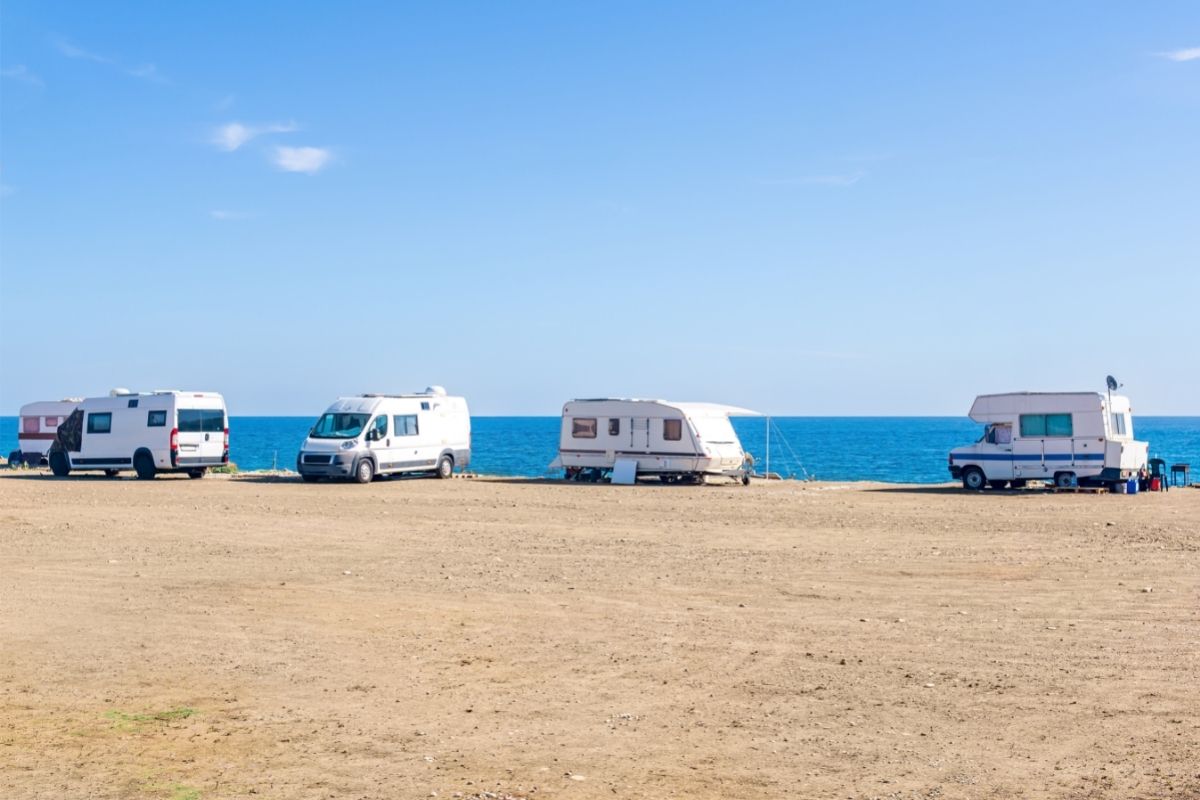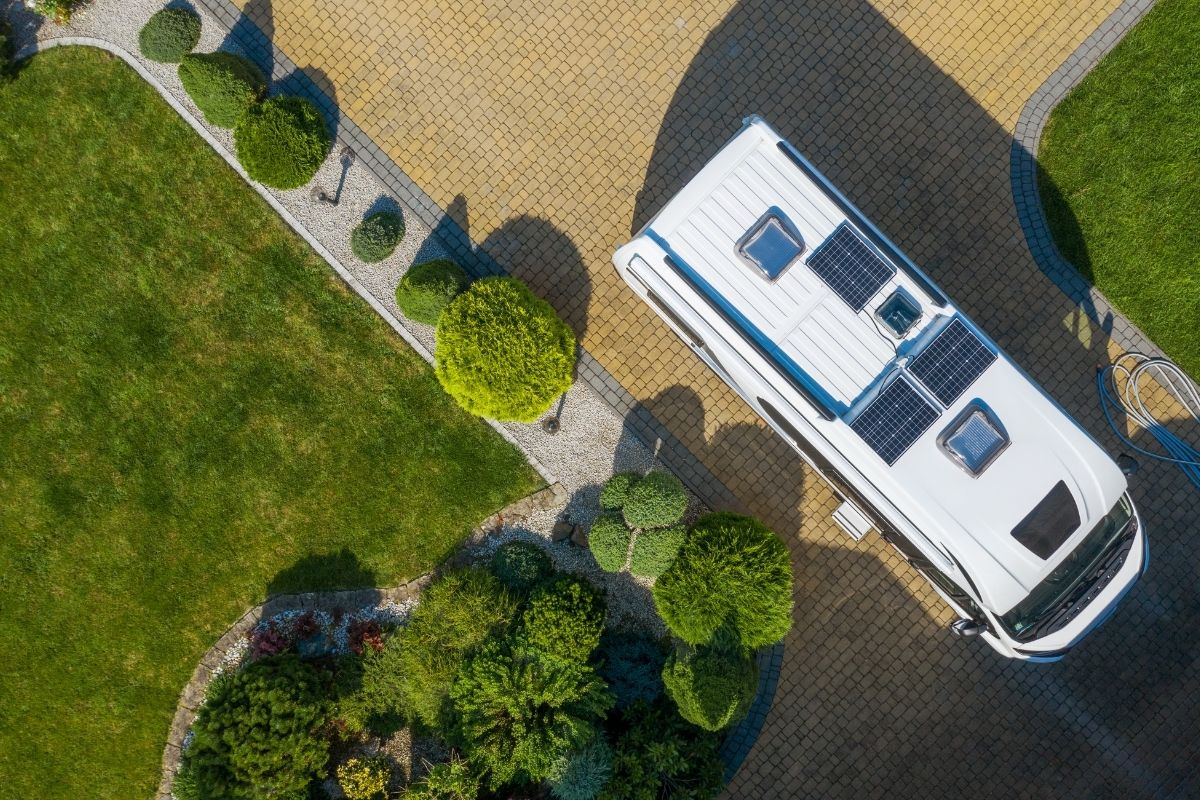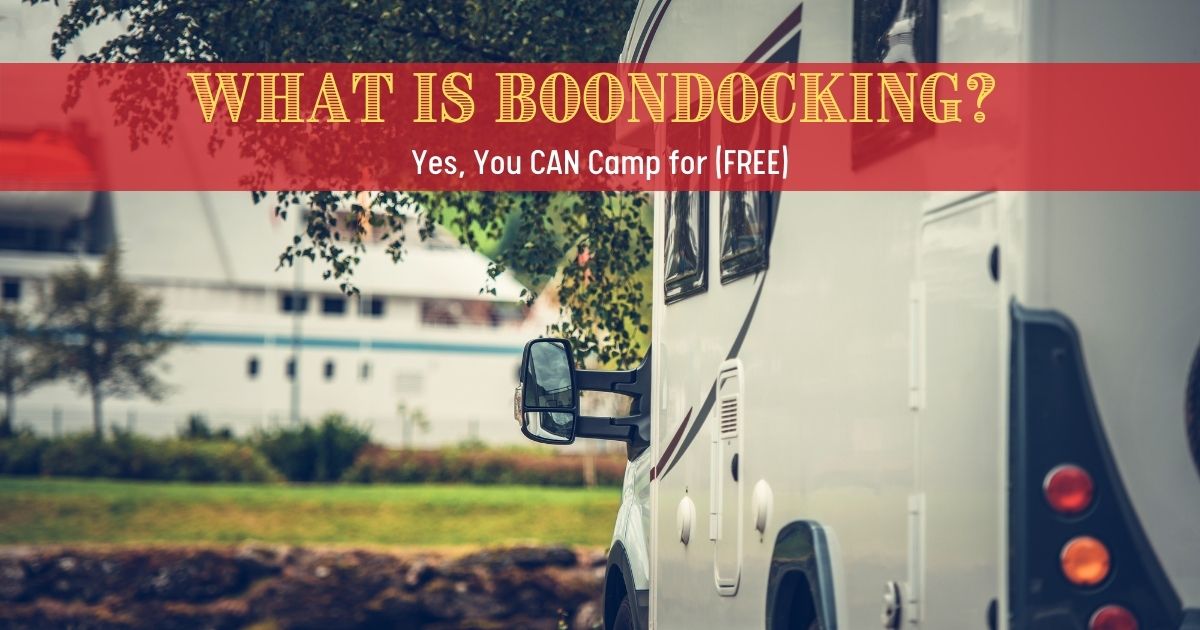What is Boondocking?
You may be wondering: what is boondocking? It is camping in remote places away from the hustle and bustle of everyday life. It’s usually free or at minimal cost, making it an attractive option for those who want some peace in their busy world without breaking any bank accounts.
Boondocking is more common these days with RVers and van lifers who camp at watersides or remote lands.

Our Top Tips for Boondocking Responsibly and Safely
It can be a little scary when you are first starting to boondock. There are so many factors that go into deciding if boondocking sites are safe and well suited to your RVing needs. We are going to look at some of the boondocking tips you need to know:
Choose a Place Where Overnight Parking is Allowed
There are many different locations where you can legally stay through the night. If you’re out in the wilderness, finding somewhere safe to boondock is just picking an area that will be remote, like BLM (Bureau of Land Management) land. But, if your goal was getting some free camping, check the following places:
Walmart Parking Lots
Boondockers can stay up to 24 hours at a time in any Walmart parking lot. Boondocking here allows you to stock up on supplies while parking for free! They will always have their own space.
Public parking lots are monitored by security, and many Walmart stores have tight policies against boondocking. The good news is that there’s an app that will help you find a nearby spot where it’s allowed!
Rest Areas/Truckstops
You should make sure you let someone know where you are since there is usually very little supervision. You’ll be close to restrooms and right off the road! Traffic can get noisy, but some rest areas in more rural locations may feel pretty similar to campgrounds, too–so do what feels comfortable.
Visitors Centers
Visitor centers often remain unoccupied during nighttime hours. They may even have access to running water, bathrooms, or other amenities. Always check with the visitor center you plan on staying at before committing your time there.
TrailHeads
Trucks are often seen at the entrances to these trails. The drivers stop for a night, park their vehicles, and sleep in them before resuming their journey early the following day.
Hotels/Motels
Suppose you are looking for an affordable place to stay while traveling, boondock in a hotel/motel parking lot. Many significant hotels won’t mind assuming their space is already pretty empty and will allow an overnight boondock camper or campers without any issues.

National Forests
The idea of boondocking doesn’t have to mean parking in a questionable or dangerous place. There are many options for parking outside, and these can be found all over forest service roads!
Other Parking Lots for Boondocking
If you find yourself at a Big Box store in the warmer months, the chances are that you will not fail to see at least a boondocking travel trailer parked outside. This is because many people take advantage of free overnight RV parking offered by stores like Walmart.
There are plenty of options for overnight parking. If you’re looking to stay the night, some popular lots include:
- Holiday Inn
- Marriot Inn
- Target
- Winco/Safeway/24 Hour Grocery Stores
- QFC (Quality Food Centers)
- Walmart
- Cabelas
- Dennys
- IHOP (International House of Pancakes)
Preparing for Your Boondocking Excursion
Before proceeding to boondocking sites, you need to prepare very well:
Prepare Your Boondocking Essentials
To be a successful boondocker, you need to ask yourself these questions:
- “Do I have enough water for my camping trips?”
- “Will food and fuel keep me going until morning when darkness falls?”
- And most importantly of all, “Am I warm from head to toe in this chilly weather?”
We always say “be prepared,” or better yet, wear your hiking boots into town just in case it gets cold while out on the open road!
Prepare Your Boondocking Trips by Downloading Maps
Download maps that will show you spots on public land like the National Forest Service or the Bureau of Land Management properties.
How to Find National Forests for Boondocking
If you’re looking for an authentic camping experience with nothing but nature and wilderness all around, look no further than excellent old-fashioned boondocking. The best part about these campsites? You can find these dry camping sites anywhere in any national forest or BLM land across America!
If there is signage noting otherwise (and sometimes even if they don’t), follow access roads until your conscience tells you it’s correct. For example, it could be against the trees near some freshwater springs while watching raccoons before falling asleep under thousands of stars overhead.
If you have a big boondocking RV, finding an accessible campsite can be difficult. They’re often not designed for RVs and may only offer limited space. If all else fails, try asking your local ranger station whether they know any good spots where you could stay overnight.
The United States Department of Agriculture (USDA) is the agency that provides guidelines on how and where you should camp in National Forests. This applies to BLM land, which stands for Bureau Of Land Management.
With the US Public Lands app, you can find public lands with free and paid campsites. However, please do your research before going deep into the woods, as it’s likely that cellphone coverage will disappear when in these remote areas!
How to Find Free Camping Sites
Are you aware there are free camping sites? Dispersed camping is a great way to experience the outdoors, but it’s not for everyone. Free campgrounds on public land can be found throughout America. These primitive sites usually require you to use what nature provides.
You may be surprised to learn that there is an alternative way of saving money on your vacation. It’s called “dry camping.” Dry camping means staying at a commercial campground without hookups and relying only on your tanks or generators. For example, RV boondocking with full hookup sites costs over twice per night for one without them!
All About Designated Dispersed Camping
The popularity of dispersed camping has led to several issues, such as littering and overcrowding. To preserve these areas for responsible boondockers, officials at The Forest Service (US Department Of Agriculture) have adopted “designated dispersed campsites.” This will deemphasize car camping within designated Wilderness Areas.
Don’t just show up at a campsite without checking first! The designated camping areas are clearly labeled, and it’s against the law to stay more than 24 hours. Ensure you know how long you are allowed to remain there before needing to apply for an extension.
Alternatives to Boondocking
Dry camping is something that not everyone gets to enjoy. It’s true freedom and independence, but certain types of dry camping do nothing for you as a boondocker. It is because they aren’t free-range or self-sufficient adventures in nature. They include:
Dry Camping in a Developed Campground
Even though you are not plugged in, there’s still plenty of amenities at developed campgrounds. You will often find vault toilets and picnic tables for use while staying onsite as well! These features make it easier to enjoy your stay with friends or family without worrying about facilities.
Parking Lot Camping
Overnight parking at a Walmart, casino lot, or truck stop is termed as dry camping and not boondocking. These places cannot be considered public land because they belong to anybody but themselves. These types of campgrounds have exciting names like Casino Camping and Wally-Docking.
Mooch Docking
Do you like to call it boondockers parking, or do the more formal terms mooch-docking? No matter what name is used for this practice, there are many benefits of having your car camping in the driveway.
Not only can one save money by not paying for an overnight stay at a campground, but also because they may be able to get closer access to their home or business.
What You Should Know Before Boondocking
Before you decide to boondock, you should know about the following fundamental issues:
How Long Will you be Boondocking?
If you’re only boondocking overnight, the process is easy. All that’s required to get through a single night in your truck camper will be water for drinking and power sources.
A boondocking RV with a generator is ideal for going off-grid, but if you’re going for more than two weeks, power requirements will be too high.
Electricity While Boondocking
Hooking up your RV without power is a more complicated task than plugging in at a traditional campground. You’ll need one or more sources for electricity and outlets, which can be challenging to come by in some areas.
First Alternative: Generators
Generators are the most common way to power your RV. They’re built into many larger motorhomes. If you have a smaller camper without this feature, consider purchasing one. If you need to run your microwave or air conditioning unit, look no further than the generator. It’s easy and efficient with just one switch on it!
Motorhomes and generators go hand-in-hand. If you have a gas rig, your generator will pull the fuel from your tank. If diesel is more up your alley, there’s no need for any extra assistance when refueling, thanks to the compression ignition. But even so, every suitable motorhome should come equipped with an automatic shutdown system. This will come in handy just in case something goes wrong.
Many people use generators to power their RV when they are boondocking. They provide the stability and peace of mind you need, but there’s one problem: not all sites allow them! If this is an issue, make sure to check with your favorite location before purchasing one.
Second Alternative: Inverters and Batteries
Another option is to use extra heavy-duty RV and deep cycle marine batteries connected to an inverter. These power sources are usually enough for running appliances, like your fridge and TV. They can also charge your laptop if necessary.
Traditional batteries may be able to power your coffee maker, but they’re not made for heavy-duty appliances like microwaves. In addition, high voltage isn’t what we recommend when you need an appliance that can handle lots of usage at once because it will drain battery life quickly.
This problem is solved without a generator with two backup sets plus an inverter. Even though an inverter may be the perfect power source, it is not a reliable long-term solution. You may need to recharge them with either an engine running or by plugging into another outlet that has access to electricity.
Third Option: Solar
Solar setup is the most environmentally-friendly and reliable power source for boondocking. This energy system can be used in conjunction with batteries, an inverter, or by itself; it all depends on your needs.
In this regard, you can’t enjoy a camping experience if you don’t have sun. Therefore, you will need to pay attention to weather patterns and plan accordingly so that your batteries are not drained too quickly!

Water While Boondocking
It would be best if you filled up your water tanks before you leave so that they are full and not rationed during extended stays. You can also buy an additional tank just for this purpose if necessary!
Internet While Boondocking
It’s essential always to be prepared for the outdoors. For example, if you’re camping, make sure that your internet is working by checking potential cell signal strength near where you’ll stay. Unfortunately, dispersed areas typically don’t have public WiFi access points. However, you can still get cellular data through a booster if needed.
Safety When Boondocking
It is essential to check in with someone before heading out to be safe. This way, they can direct search parties if necessary and help avoid any accidents on your journey.
Boondocking can be an excellent opportunity for self-discovery, but it comes with its share of risks. There is the risk that animals like bears or mountain lions may come into contact with humans. Boondockers should always take extra precautions because the animals may cause harm.
Boondocking Tips for Beginners
It can be a bit intimidating for those who have never boondocked before. But fear not! You will make mistakes, and that’s okay because they’re an essential part of learning.
Here are a few essential tips for first-time boondockers:
- Save time and energy by charging up phones, laptops, or camera batteries ahead of time.
- Be conservative with your power to keep batteries healthy, save on gas, and run your generator less.
- Stock up on groceries.
- Do laundry ahead of time.
- Pack extra supplies in case you need to stay longer than planned.
- Have fresh water in your tank.
- Arrive during daylight.
- Double-check the weather forecast. (If the weather is going to dip below freezing, make sure you’re prepared.)
- Check if the camping area has designated generator hours and plan accordingly.
- If using solar panels, make sure you have an inverter.
- Like a stovetop espresso maker, bring along small appliances that use limited power.
In Summary
By now, you can answer the question: What is boondocking camping? But before boondocking, you can try dry camping. It is a fantastic way to test the waters and see if you want to boondock.
While it may not always feel authentic, an RV Park or your driveway will provide excellent practice before taking on longer trips!
